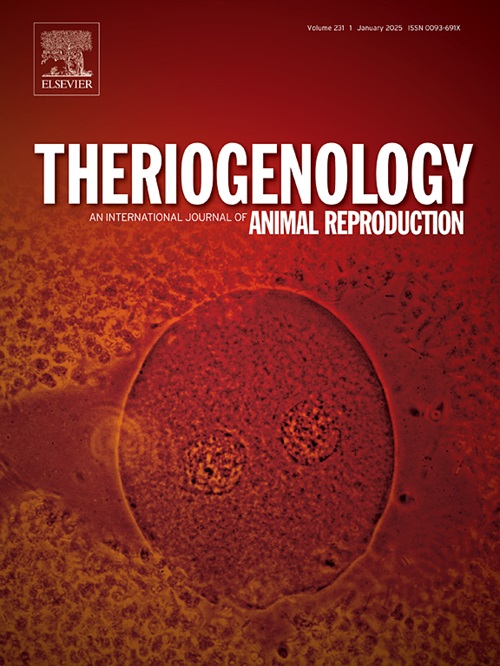围产期抗凝疗法可提高超排卵母马的胚胎复苏率
IF 2.4
2区 农林科学
Q3 REPRODUCTIVE BIOLOGY
引用次数: 0
摘要
虽然在马匹中已经描述了超排卵的方案,但由于超排卵母马的胚胎恢复率很低,这种技术一直不被看好。造成这些不良结果的原因尚不清楚,但有一种假设是排卵后在排卵窝中形成了血凝块。因此,本研究旨在评估围排卵期抗凝疗法对超排卵母马胚胎恢复的安全性和影响。在实验 1 中,五匹母马被交叉分配接受五种抗凝剂治疗:静脉注射 150 (H1)、300 (H2)、400 (H3)、450 (H4)、600 (H5) IU/kg 的非分细肝素(UFH,肝素钠);并在治疗后 48 小时内依次采集血样,以检测凝血酶原(PT)和活化部分凝血活酶时间(aPTT)。在实验 2 中,四匹母马接受了交叉设计,静脉注射 450 IU/kg UFH 和 1 mg/kg 低分子量肝素(LMWH,依诺肝素),并按照之前的方法采集血液以分析血浆抗 Xa 活性。在实验 3 中,11 只母马被随机分配到 4 个周期的 4 个组。在对照组中,母马没有接受任何治疗。而在 G1、G2 和 G3 组中,母马使用马垂体提取物进行超排卵,并在诱导排卵 34 小时后使用安慰剂(氯化钠 0.9%,G1)、450 IU/kg UFH(G2)或 1 mg/kg LMWH 进行治疗。所有组别中的母马均使用 hCG 加醋酸组曲林诱导排卵,并使用一匹种公马的新鲜精液进行配种。胚胎冲洗在排卵后九天进行。在实验 1 中,只有 H4 和 H5 组母马的 aPTT 和 PT 值在 12 小时内升高,所有组的 aPTT 和 PT 值都在治疗后 24 小时内恢复到基线。在实验 2 中,两种疗法都能在治疗后 12 小时内提高血浆抗 Xa 活性,并在治疗后 24 小时达到基线水平。在实验 3 中,与对照组周期(60%;P <0.05)相比,围排卵期抗凝剂疗法提高了每个周期的胚胎复苏率(G2,250%;G3,260%),而 G1-assigned 周期(160%)的胚胎复苏率处于中等水平。总之,围排卵期抗凝疗法可能是改善超排卵母马胚胎恢复的一种替代方法。本文章由计算机程序翻译,如有差异,请以英文原文为准。
Periovulatory anticoagulant therapy enhances embryo recovery rates in superovulated mares
Although protocols for superovulation have been described in horses, this technique has been discouraged due to the low embryo recovery rates in superovulated mares. The reason for these poor results is poorly understood, but the formation of a blood clot in the ovulation fossa following ovulations has been hypothesized. Therefore, this study aimed to assess the safety and effect of periovulatory anticoagulant therapy on embryo recovery of superovulated mares. In experiment 1, five mares were assigned to receive five anticoagulant treatments in a crossover design: intravenous injections of 150 (H1), 300 (H2), 400 (H3), 450 (H4), 600 (H5) IU/kg of unfractionated heparin (UFH, heparin sodium); and had blood samples sequentially collected for up to 48 h post-treatment to test Prothrombin (PT) and activated partial thromboplastin time (aPTT). In experiment 2, four mares were treated in a crossover design with intravenous injection of 450 IU/kg of UFH and 1 mg/kg of low molecular weight heparin (LMWH, enoxaparin) and had blood collected as previously for analysis of plasma anti-Xa activity. In experiment 3, eleven mares had four cycles randomly assigned to four groups. In the control group, mares did not receive any treatment. In contrast, in groups G1, G2, and G3, mares were superovulated with equine pituitary extract and treated 34 h after the induction of ovulation with a placebo (NaCl 0.9 %, G1), 450 IU/kg of UFH (G2), or 1 mg/kg of LMWH. Mares in all groups had ovulation induced with hCG plus histrelin acetate and were bred with fresh semen from one stallion. Embryo flushing was performed nine days post-ovulation. In experiment 1, only mares in groups H4 and H5 had increased aPTT and PT for up to 12 h, and in all groups, aPTT and PT values returned to baselines at 24 h post-treatment. In experiment 2, plasma anti-Xa activity was increased by both therapies for up to 12 h after treatment and was at baseline levels 24 h post-treatment. In experiment 3, periovulatory therapy with anticoagulants increased embryo recovery rates per cycle (G2, 250 %; G3, 260 %) compared to control-assigned cycles (60 %; P < 0.05), whereas G1-assigned cycles (160 %) had intermediate embryo recovery. In conclusion, periovulatory anticoagulant therapies may be an alternative to improve embryo recovery in superovulated mares.
求助全文
通过发布文献求助,成功后即可免费获取论文全文。
去求助
来源期刊

Theriogenology
农林科学-生殖生物学
CiteScore
5.50
自引率
14.30%
发文量
387
审稿时长
72 days
期刊介绍:
Theriogenology provides an international forum for researchers, clinicians, and industry professionals in animal reproductive biology. This acclaimed journal publishes articles on a wide range of topics in reproductive and developmental biology, of domestic mammal, avian, and aquatic species as well as wild species which are the object of veterinary care in research or conservation programs.
 求助内容:
求助内容: 应助结果提醒方式:
应助结果提醒方式:


